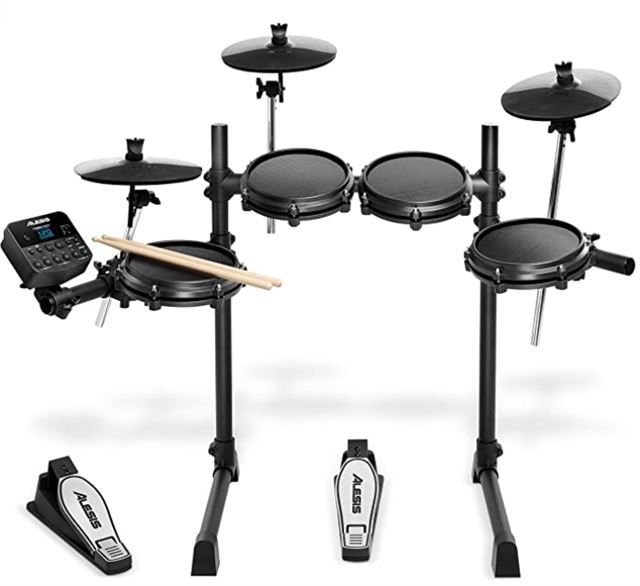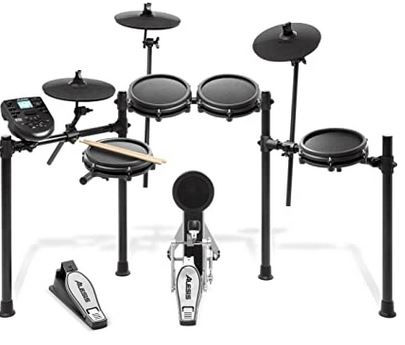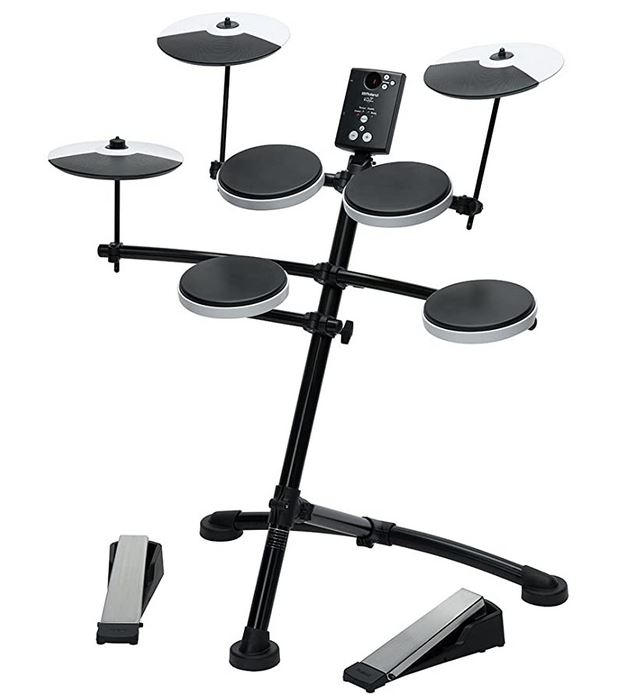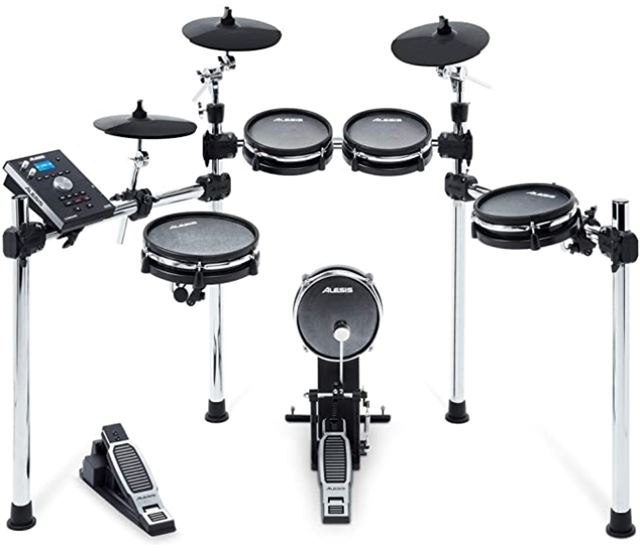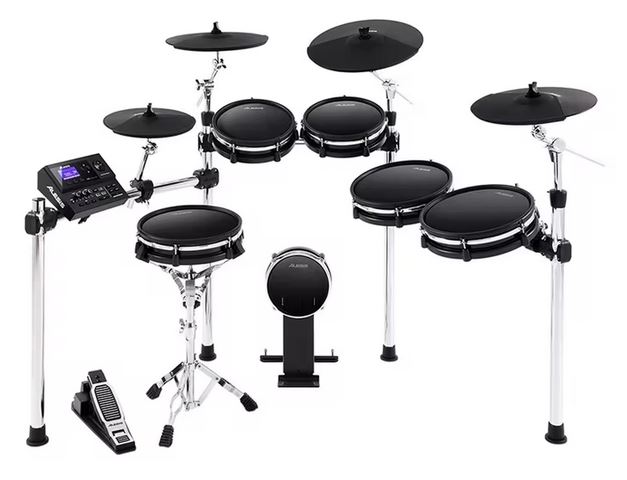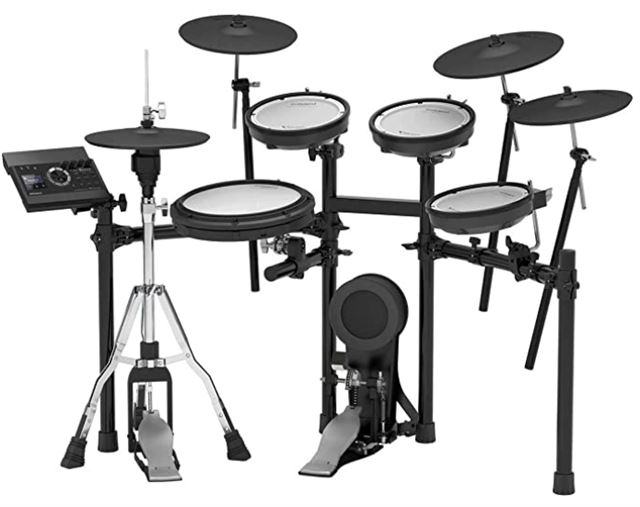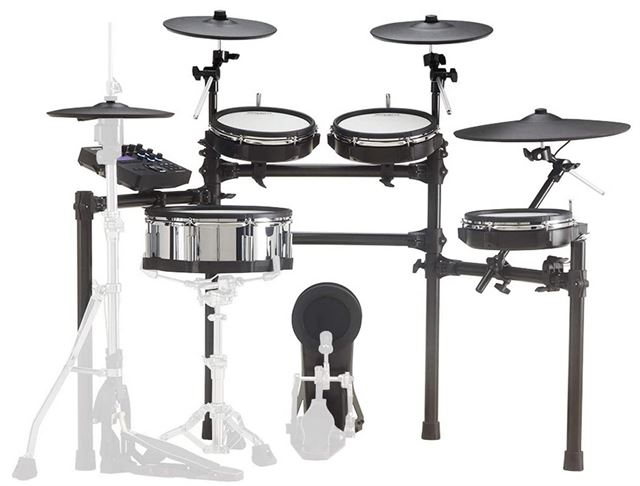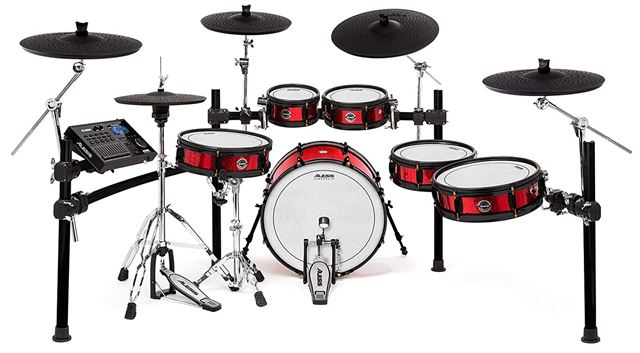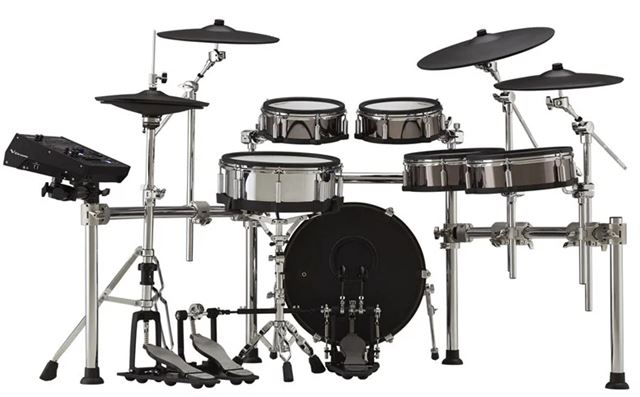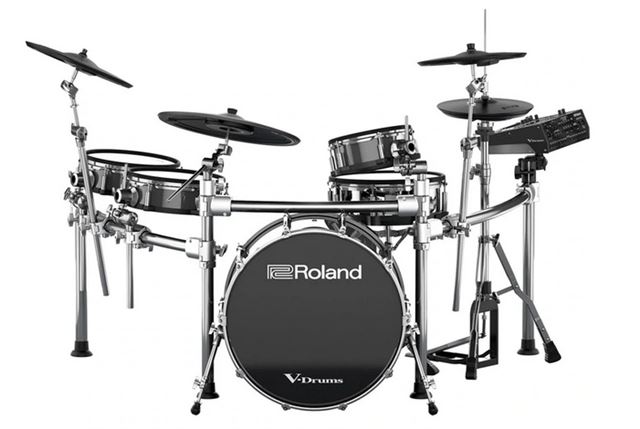
10 Best Electronic Drum Sets for Beginners and Pros
Drums are the backbone of almost all musical tracks, and they come in multiple shapes and sizes. But drum sets are a distinctly unique category of percussion, and they tend to belong to one of two groups: Acoustic and electronic.
Acoustic drum sets are the more traditional choice, but there are several reasons to choose electronic drum sets (often called e-kits) instead. For example, electronic drums are lightweight, compact, and capable of playing hundreds or thousands of sounds.
Electric drum sets are also a discrete way to master basic drum techniques; moreover, you can play them with headphones. As such, you won’t bother roommates or neighbors while developing your paradiddle speed or learning to move around the kit.
Without further ado, let’s explore the best electric drum kits for beginners and pros!
Contents
Best Electric Drum Kit Brands
Before investing in an electronic drum set, you’ll want to familiarize yourself with some of the top brands. Doing so can help you select a high-quality e-kit (and avoid lackluster drum sets).
For example, some of the best brands for electric drums include:
- Alesis
- Roland
- Simmons
- Yamaha
- Donner
- Behringer
- KAT
- EFNOTE
- ATV
- Nux
You might find electronic drum sets from other brand-name companies. But those kits might not stack up in terms of the quality, value, and capability found throughout the brands listed above.
Best Electronic Drum Sets of 2025202520252025
| Pros | Cons | |
| Roland TD-50KVX |
|
|
| Alesis Turbo Mesh |
|
|
| Alesis Nitro Mesh |
|
|
| Roland TD-1K |
|
|
| Alesis Command Mesh |
|
|
| Alesis DM10 Studio Kit MKII |
|
|
| Roland TD-17KVX |
|
|
| Roland TD-27KV |
|
|
| Alesis Strike Pro SE |
|
|
| Roland TD-50KV2 |
|
|
What’s the Best Overall E-Kit?
In our opinion, the Roland TD-50KVX is the best e-kit in terms of features, benefits, and price. Naturally, you might prefer one of the other high-quality kits we reviewed.
We think the Roland TD-50KVX is the best all-around option, especially for those looking to enjoy the highest-quality and greatest range of sound from their electronic drums. But this drum set is also pricier than others. It also has a powerful module that can be a little overwhelming for beginner-level players.
That’s why we recommend it for intermediate and advanced drummers, as well as beginners that are looking to make a long-term investment in an e-kit. The Roland TD-50KVX is also easy to find and order online, which is a significant plus.
Where to Order an Electronic Drum Set
One of the best ways to purchase an electronic drum set is to shop online. Many online retailers have several e-kits from some of the top brand names, including Roland, Alesis, Simmons, and Yamaha.
Before purchasing a kit, be sure to compare sales, included accessories, and drum set features. Or, if you’d rather skip the browsing process, you can invest in our top pick, the Roland TD-50KVX.
Why Is the Roland TD-50KVX the Best?
The Roland TD-50KVX electric drum set is our overall top pick because of its super-sensitive mesh cymbal and drum heads, its traditional acoustic look and feel, and its massive multi-channel module.
Whether you’d like to learn how to play drums without waking everyone in your home, or you’re looking for a professional-quality electronic drum set to play in a recording studio, the Roland TD-50KVX isn’t likely to let you down.
Musicians that play live performances will also appreciate the multi-channel capabilities of this e-kit’s module. This is a powerful, durable, and top-quality electronic drum set. That’s why it’s our top pick!
10 Best Electronic Drum Sets
- Roland TD-50KVX
- Alesis Turbo Mesh
- Alesis Nitro Mesh
- Roland TD-1K
- Alesis Command Mesh
- Alesis DM10 Studio Kit MKII
- Roland TD-17KVX
- Roland TD-27KV
- Alesis Strike Pro SE
- Roland TD-50KV2
1. Roland TD-50KVX
When you’re looking for the best electronic drum set, you don’t need to look much farther than the Roland TD-50KVX. That’s because this capable e-kit features everything that expert drummers look for in a electric drum set: Variable-sized cymbal and drum head pads, a traditional look and feel that adds durability to the set, and a capable module with multiple channels and inputs.
While this drum set doesn’t include two rack toms, it does come with two steel-supported floor tom heads and a total of four cymbal heads. The dual hi-hat heads are particularly attractive due to their improved sensor load and controller pedal.
Still, this electronic drum set’s primary advantage is the included module. It’s one of the most massive modules ever built for a Roland e-kit, allowing it to display an easy-to-read screen alongside dozens of well-labeled control knobs and buttons. You can customize your kit and triggers and control the individual volume of each input with just a few pushes and turns!
Pros
- Built for studio and live performances
- V-Drums module is one of the most advanced and capable of the entire Roland e-kit lineup
- Comes with multi-size cymbal and drum head pads
- MIDI, USB, and SD ports
- Comes with a drum rack
- Pads are built into wooden shells for improved aesthetics and stability
Cons
- One of the priciest electronic drum sets available
- May be too intimidating for beginner-level drummers
- Not the best choice for compact studio spaces
2) Alesis Turbo Mesh
Beginner-level drummers don’t necessarily need all of the hi-tech power found in professional electronic drum kits. Novice drummers also aren’t likely to spend several thousand dollars on a new e-kit. Fortunately, there are budget-friendly models like the Alesis Turbo Mesh to help fill the gap.
Even though this kit is far less than the average electric drum set, it offers several features that make it a surefire choice for most beginners. For example, it folds to a nearly flat state for fast and simple storage, and it’s one of the most compact options available.
The module features large labeled buttons, and users can choose from dozens of drum lessons to improve their skills. While advanced-level drummers might not enjoy this drum set, it could be the ideal first e-kit for beginners.
Pros
- One of the most affordable beginner-level e-kits
- Folds away for fast and convenient storage
- Comes with more than 50 drum lessons
- Uses high-quality mesh heads instead of cheaper rubber ones
- Easy-to-use module with large buttons
Cons
- Only includes about ten drum kit sound groups
- Not a great choice for live performances
- No MIDI connections
3) Alesis Nitro Mesh
Looking for an upgraded version of the Alesis Turbo Mesh? If so, be sure to consider the Alesis Nitro Mesh. This kit has four times as many drum kits and a stronger rack frame to keep your heads and cymbals secure.
The only potential downside for most players is the lack of drum head size variability. Each drum head pad is eight inches, far smaller than what most traditional drummers are accustomed to.
Pros
- A high-value upgrade that includes a bass pedal with a kick pad
- More frame stability than the Alesis Turbo Mesh
- Comes with high-response mesh drum heads
- Includes more than 350 sounds and 40 kits
- Backlit module is easy to read and simple enough to keep beginners comfortable
Cons
- Heads are all 8-inch, which may be too small for some drummers
- Aluminum frame may be more prone to warping, especially over time
- Drummers cannot upload their own sounds to this module
4) Roland TD-1K
The Roland TD-1K is the most budget-friendly electronic drum set in the Roland lineup, and it’s also easy to set up and store. This kit utilizes a tripod-like frame that can adjust for easier storage inside closets or beside walls.
When you’re ready to play, simply unfold this rack’s legs, grab a throne, and press the module’s power button! At just slightly over 25lbs, finding an e-kit that’s easier to install and transport is challenging. But don’t expect many module frills–these drums can only play a handful of different kit sounds.
Pros
- A compact option for even the smallest studios
- Tripod-like stand is easy to set up
- Lowered pad rim for easier striking
- One of the best choices for beginners
- Lightweight and easy to transport
Cons
- Module only offers on USB port
- Comes with a small selection of kit sounds
- Pricier than other entry-level electronic drum sets
5) Alesis Command Mesh
The Alesis Command Mesh electronic drum kit is a mid-range option that’s suitable for beginners and intermediate players. For example, users can upload tracks via USB memory sticks, significantly shortening the track transfer process.
While this feature might not be impressive to pro-level drummers, it’s a fantastic upgrade on budget-level kit functions. You could even create your own custom drum kits and save them onto the module for later use!
But those accustomed to traditional drum sets might struggle with this option. After all, the drum and cymbal pads are all slightly smaller than what you’d find on a traditional kit. As such, each player’s aim must be far more exact to achieve the desired sound.
Pros
- Module contains a built-in sequencer and recorder for immediate recording and playback
- Includes bass and hi-hat controller pedals
- Accepts USB memory sticks for faster file uploads
- Users can upload self-made drum kits for a personalized experience
Cons
- Comes with a relatively low number of sounds and kit options considering the price
- Smaller drum head and cymbal pads can be challenging to strike correctly
- Snare pad tends to wear out within a few months of consistent usage
6) Alesis DM10 Studio Kit MKII
The all-mesh dual-zone drum pads found on the Alesis DM10 Studio Kit MKII are only one of the reasons why it’s popular among beginner and pro-level drummers. The four included cymbals, well-positioned module, and bass drum kick pad are also attractive features that keep players coming back for more.
This electronic drum set is one of the better options for those looking to produce studio recordings, as the module has both USB and MIDI ports and allows users to upload WAV and MP3 tracks.
Of course, the module also comes with 100 convenient play-along tracks, enabling beginners and intermediate-level drummers to master new songs and techniques quickly. Still, you will need to purchase the bass drum pedal separately.
Pros
- Includes a full drum set; Two rack toms, two floor toms, three ride/crash symbols, one hi-hat
- Module has both USB and MIDI ports for easier live and recorded performances
- Comes with about 100 play-along tracks and the ability for users to upload WAV and MP3 sample files
- All drum head pads are dual-zone
Cons
- Kick pedal and drum amp sold separately
- One of the heaviest electronic drum sets
- Not an excellent choice for compact spaces
7) Roland TD-17KVX
Contrary to what you might think, you don’t have to spend more than $2,000 to enjoy an intermediate-friendly Roland electronic drum set. The Roland TD-17KVX might not be quite as powerful as the TD-50KVX, but it’s an affordable option for those looking to progress from beginner-level to intermediate or advanced.
And unlike other Roland-brand e-kits, this model features a bass pedal kick pad that’s attached to the rack frame. As such, you won’t ever need to worry about your bass pedal skidding across the floor while you play!
Still, the module display screen is far smaller than screens found on comparable models. So, if you struggle to read smaller print, you might want to upgrade to the more capable TD-50KVX or TD-50KV2.
Pros
- More affordable than similar Roland e-kits
- Bass pedal kick pad attached to frame for greater stability
- Comes with a dedicated ride cymbal in addition to ride/crash, crash, and hi-hat cymbal pads
- Heavy-duty drum stand and rack are included
- Includes high-quality mesh V-Drums pads for snare, two rack toms, and one floor tom
Cons
- Not well-suited to small spaces
- May be too pricey for beginners
- Module display screen is small and can be challenging to read
8) Roland TD-27KV
When you choose Roland, you know you’re choosing a high-quality product. The Roland TD-27KV is no exception, offering a relatively full kit that’s pre-programmed with hundreds of unique sounds.
The mesh drum head pads are far superior to standard rubber options, and the 14-inch snare pad is a massive improvement on the same-sized pads available on budget models. While you will pay a little more for this electric drum set than you would for an entry-level model, you’ll also enjoy a higher quality of pad sensitivity and sound playback.
Pros
- The 18-inch ride cymbal pad is far easier to strike than smaller pads
- Comes with a slightly wider and more responsive 14-inch snare pad
- Module comes pre-loaded with more than 700 unique sounds
- Easy-to-read and operate module is ideal for beginners and advanced players
Cons
- Floor tom pads aren’t included
- Bass drum kick pad isn’t secured to a rack
- Rack, kick pedal, and hi-hat stand may be sold separately
9) Alesis Strike Pro SE
If you’ve got plenty of space to spare and you’re looking for one of the most complete electronic drum sets available, you might want to check out the Alesis Strike Pro SE.
Not only does it resemble a traditional kit, with bright red wood-and-metal shells and a massive bass drum foot pad, but it also comes with two rack toms and two floor toms, just like a standard full-sized drum set. The tom head pads are all different sizes, making it easier for players to strike them just right and achieve an authentic sound.
Still, the plastic hardware does leave a lot to be desired, and the kick pedal and hi-hat stand aren’t included. Additionally, the module can be a little overcomplicated for beginner-level players, and it doesn’t come with a sequencer.
Pros
- Excellent value option for intermediate and advanced drummers
- One of the most aesthetically pleasing e-kits
- Comes with a full array of tom pads (8-inch to 14-inch)
- Includes three crash cymbals
- More than 1,800 sounds programmed in the module
Cons
- Drum module might be too complicated for novice players
- Doesn’t come with hi-hat stand or kick pedal
- Module doesn’t come with a sequencer
10) Roland TD-50KV2
In some ways, the Roland TD-50KV2 is an upgraded version of the Roland TD-50KVX. For example, it comes with two rack toms as well as two floor toms. It also comes with a double bass pedal that’s bound to suit metal and rock drummers.
That said, this electric drum set is a little pricier than the TD-50KVX. It’s also slightly wider and heavier, making it a more challenging model for musicians to transport easily. And surprisingly, this model’s module controller offers fewer inputs and control than our top pick.
If you’re looking for a version of the Roland TD-50KVX that includes an additional bass pedal and rack tom, you might enjoy the Roland TD-50KV2. But in terms of playability, this model is better suited to studio drummers than live performers.
Pros
- A unique combination of traditional drum shells and cutting-edge mesh pads
- One of the few e-kits that comes with a double bass pedal
- Includes two rack toms instead of one
- Has an exceptionally sensitive open/close rubber pad hi-hat cymbal
Cons
- One of the priciest Roland electronic drum sets
- Heavier and wider than other electric drum kits
- Premium sounds require a Roland Cloud paid membership
What Are the Features of the Best Electronic Drum Set?
If you’ve never purchased a digital drum set before, you might not be familiar with what features to look for. Fortunately, we’ve got the skinny on what to keep an eye on.
Some of the most crucial things you’ll want to look for when choosing the best e-kit include:
- E-Drum Kits Parts
- Electronic Drum Head Types
- Electronic Drum Accessories
Let’s delve a little more deeply into these aspects to discover why they’re important. We’ll also discuss the types of options you’ll have and which might work best for you.
E-Drum Kit Parts
Except for drum heads, the essential parts of an electronic drum set are the following:
- Stands/Frame
- Module
- Cymbal heads
When choosing a new kit, you won’t want to neglect these components. Remember, plastic stands and frames can crack and fall apart far faster than steel or aluminium ones. And the right module can make all the difference when it comes to sound variety and quality.
Stands/Rack
An e-kit without stands or a rack is essentially an overlarge strike pad drum module. For proper playing, your electronic drum heads need somewhere secure to stand or hang. That’s why it’s vital to select high-quality metal stands and racks.
Soft drummers are few and far between, and it’s easy to lose a drum head or a stand when striking hard. Plastic stands are inexpensive and lightweight, but they can quickly degrade after multiple drumming sessions.
Steel is the best way to go if you’re searching for stands or frames that can keep your heads and cymbals grounded and secure. Telescopic steel is even better, as it’s easy to collapse and carry.
Module
An electronic drum set’s module is essentially its brain. Its primary purpose is to transform the signals sent from the drum head triggers into audible sounds. It’s also what helps drummers choose specific sound presets.
In short, the module is both the computer and the display screen that allows e-kits to function.
Most beginner-level drummers won’t want to mess around with their drum set’s module. But those looking to build their own kit or upgrade an older module model can choose standalone modules for their kit.
Modules come in many styles and capabilities, which is something you’ll want to be aware of when selecting a new one for your drum set. For example, many of the best Roland e-kit modules have easy-to-read display screens, sleek wheel adjusters, and simple control buttons.
But the average Yamaha module is a little more analog, typically relying on several turning knobs and switches to help you adjust metronome tempo, kit sound options, and volume. Still, it’s often a great idea to choose a module that’s brand compatible.
So, if you’re playing on a Roland set, you’ll want to choose a Roland module. The same is true for those playing on Alesis, Yamaha, or Simmons electronic drums.
Cymbal Heads
The majority of electronic drum cymbal pads are made of hard rubber. Some have sensors inlaid throughout, making it possible to strike them almost anywhere and produce a sound. Others have specific strike zones that players must aim for.
Generally, the higher-end options are those with multiple triggers, as they allow for a more natural and varied range of striking. But if you’re on a tight budget, or you’re simply looking for a sturdy pair of beginner-friendly electronic cymbals, you might want a few single-trigger cymbals.
Notably, the hi-hat cymbal won’t consist of two pads. Unlike traditional hi-hats, electronic hi-hats are controlled via their internal strike trigger (inside the rubber pad) and a paired electric hi-hat pedal.
For the shortest response time, be sure to invest in a hi-hat controller pedal that’s easy to depress and quick to rise. Yamaha and Roland make some of the best controller pedals, so you may not need to upgrade the one that comes with your kit if you buy from these brands.
It’s also worth mentioning that some of Roland’s best pro-level electronic drum sets do feature open/close hi-hats with traditional pedals. These function using sensitive rubber cymbal pads that register minute pressure differences as well as strikes.
Electronic Drum Head Types
Not all electronic drum heads are identical. Just as with traditional drum heads, they tend to come in a variety of sizes. A few standard electronic drum head sizes include:
- 10-inch
- 12-inch
- 14-inch
- 16-inch
- 22-inch
Notably, the size of an electronic drum head doesn’t necessarily correspond to the sound it generates. That’s because electric drum sets function via pre-programmed sound cues.
So, you could easily have a set that consists of 14-inch drum heads, but have them each produce a different tone. One of the primary reasons that drummers may choose to differentiate drum head size with an e-kit is to increase striking surface area.
Another common reason is that it gives the set a more traditional look and feel that’s compatible with a wider pool of players. However, size alone isn’t the only thing that differentiates electronic drum heads.
Material is another significant factor. Some are flat, disc-like components that lack shell bodies. These are rubber pad heads, and they tend to be the least expensive option.
Others resemble traditional drum heads and can fit neatly inside of shells (or remain plate-like on a stand). These are mesh drum heads, and as you might have guessed, they can be a little pricier.
If you’re going for quality, you’ll always want to choose mesh heads. They’re more expensive than rubber heads, but they often last longer, produce higher-quality sound and are more sensitive to touch.
Electronic Drum Accessories
You’ll also want to keep an eye on included and available electronic drum accessories. Some of the most practical and convenient of these add-ons include:
- Headphones
- Amps
- Monitors
- Carrying bags
- Nylon drum sticks
Each of these accessories can make your drumming experience far more comfortable and productive, but only if you know how to use them. Which ones might make all the difference for you and your e-kit? Let’s find out!
Headphones
One of the best aspects of playing an electronic drum set is that you can go just about as loud as you’d like without causing your neighbors to lose their minds!
While the sounds of your sticks against the drum heads will make a loud tapping noise, the kit’s module controls the volume of the pre-recorded tones. If you’d like to play quietly, you can crank down the module’s volume control.
Or you could plug your headphones into the audio jack (also located on the module). Doing so will allow you to hear your drumming privately. And when your headphones are on, you can turn up the volume and enjoy every tap you make across the heads and cymbals.
Naturally, you’ll want to resist turning the module volume up to an ear-splitting level. Unless, of course, you’re planning on playing your kit for a live audience. But in that case, a pair of drum kit headphones might not be as useful as a new amp.
Amps
Unless you’re investing in a beginner-friendly electronic drum set, you’re likely going to want to have a drum amp or monitor available. That’s because most e-kit modules aren’t equipped with a speaker.
Consequently, to hear the sounds you’re producing, you’ll either need a pair of headphones or an amplifier. And if you’re going to be playing live, either in a recording studio or for an audience, you’ll want to make sure you’re investing in an amp designed to handle an electric drum set.
Fortunately, many of the same brands that make the best electric drums also produce drum amps. If you don’t currently own an amplifier, be sure to consider investing in a Roland, Simmons, or Behringer drum amp.
Carrying Bags
Breaking down an electronic drum kit is hardly ever fun, but you can make it easier with the help of a nifty carrying case. Many e-kit carrying bags have small slots designed to accommodate individual drum heads. Some also have pockets for collapsible stands and drum pedals.
So, if you plan on traveling with your electronic drums, a carrying bag could make your life considerably easier. But if you’re mostly going to practice your drumming from the comfort of home, you might want to invest in a different accessory, like a new pair of nylon drum sticks.
Nylon Drum Sticks
When it comes to electronic drum pads, standard wooden drum sticks might not offer enough connection, striking precision, and bounce. But nylon drum sticks tend to offer just the right combination of weight, balance, and strike.
If you’re still toting around a chipped-up pair of wooden sticks, be sure to trade up for a nylon pair when you order your new e-kit. Doing so will help you keep your electronic drum heads in tip-top shape while also allowing you to enjoy a more immediate response from your drums.
What Are Your E-Kit Needs?
One of the best ways to determine which electronic drum kit might be best for you is to take a moment to consider your needs. For example, do you need an e-kit that’s easy to pack up and transport to venues? Or is recording quality a bigger priority for you?
Asking these questions can guide you toward a kit that’s perfectly matched to your needs. All in all, be sure to consider:
- Transportation
- Recording
- Live Gigs
- Best-sounding Drums
Now, let’s take a quick moment to explore these aspects. After all, if you’re not quite sure what you need from your new electronic drum set, you may struggle to select one that has the right features!
Transportation
Hauling an acoustic drum kit around can be a nightmare, as shells can crack under the pressure of other gear, and heads are easily pierced. But electronic drums are a little sturdier and easier to tote around. This is especially true of smaller kits (one snare, two toms, two cymbals, one bass) with thin rubber heads.
However, while minimalist electric drum sets with rubber pads might be the best option in terms of transportation, they’re often not the best choice when it comes to recording music. You’ll likely want to focus on a kit with higher-quality mesh heads and a capable module for studio recording.
Recording
You can connect the audio output on your e-kit’s module to a computer to record digital music that’s free from acoustic interference. This type of recording is well-suited to those attempting to create professional-quality music with their electronic drums.
That said, rubber pads don’t tend to generate the best sound quality. And if you’re going to be showing off your drummer skills, you may want to invest in a few extra heads, stands, and cymbals.
Ensuring that there are enough heads means having every tone immediately available to you. As such, you’ll be able to move around your kit seamlessly while recording, never having to adjust head tones and sounds unless you want to.
Of course, this type of setup might not be the best choice for live gigs. When it comes to playing electronic drums for a live audience, it’s typically better to find a middle ground between compact design and high-quality sound production.
Live Gigs
Playing live music is a dream come true for many drummers. An electronic drum set could make it far easier to achieve the desired tones, and they’re relatively easy to connect to synthesizers and loop machines. As such, an e-kit could be beneficial for almost any music genre or style.
That said, you will need an amp (or a monitor) to play an electric drumset live. You’ll also want to choose a kit that’s relatively easy to set up and take down, as you may be one of several acts playing a stage during a given performance night.
It’s also crucial to choose a drum set that produces high-quality sound when you’re choosing to play live. We’re talking mesh drum heads, upgraded modules, and sturdy metal stands and frames.
Naturally, your chosen genre will help you select the best possible kit for your live shows.
For example, if you play jazz drums, you can invest in a handful of high-quality mesh heads, pedals, and stands. But if you play heavy metal drums, you’ll likely need to double or triple that investment.
Best-sounding Drums
For professional drummers, the highest priority might be finding an electronic drum set that’s capable of producing the highest-quality sounds.
In this instance, it’s almost always best to go with a varied kit that comes with several mesh drum heads and a handful of rubber pad cymbals. It’s also crucial to consider the brand.
Roland and Alesis tend to produce electronic drums with the most durable and reactive components. Most of these kits lend themselves well to pro-level electronic drumming, regardless of your transportation, recording, and live gig needs.
Still, we recommend going for the Roland TD-50KVX if you’re serious about enjoying the best-sounding electric drums. This kit has it all:
- Multi-size cymbal and drum heads
- Wooden pad shells
- Multi-sensor surfaces for precise sound triggers
- Multi-channel module that’s built for studio recording and live performances.
It’s one of the best-sounding electronic drums we’ve ever discovered.
Where to Buy a Used Electronic Drum Kit
Used electronic drums for sale are easy to find at local music stores and online. That said, you’ll find a wider selection of used kits when searching online.
Some of the best places to search for kits include online auction marketplaces, local barter marketplaces, and used instrument retailers. You can also ask fellow drummers or drum instructors about local sellers if you’re determined to find the best price on a nearby kit.
Frequently Asked Questions
Below you will find answers to some of the most frequently asked questions regarding electronic drum sets. If you can’t find your question below, be sure to contact us today for more information!
What is the best electronic drum set?
The best electronic drum set for you depends on your current skill level, preferences, and budget. We think that the best electronic drum set is the Roland TD-50KVX. This e-kit comes with some of the highest-quality cymbal and drum pads, as well as a sturdy rack that won’t bow down to pressure.
That said, the Roland TD-50KVX electronic drum set might not be your top choice. After all, it’s pricier than other electronic drums and can be challenging for beginners to master. The module’s many channels and settings can quickly feel overwhelming if you’ve never used electric drums before.
For that reason, the best electronic drum set is one that:
- Has easy-to-strike pads
- Isn’t above your price limit
- Fits into your studio or home space
- Comes with plenty of sounds to experiment with
- Meets your e-kit needs (recording, live gigs, etc.)
How much does an electronic drum set cost?
The price for an electronic drum set varies depending on the kit’s size, sound quality, and the number of pieces. Generally, a cheap electronic drum set for beginners starts at about $200. But professional-level electric drum sets can cost more than $8,000.
A great starting price for an excellent-quality electronic drum set for beginners or pros is about $1,000. At this price, novice drummers can enjoy a better experience than they would with cheaper sets, and professional players can choose upgrades that fit their precise needs.
How do you set up an electronic drum kit?
If you’ve purchased a brand new electronic drum kit, you’ll likely receive a copy of paper instructions describing how to set up your new kit. You may also receive a link to an online instructional video.
Still, if you’ve got a new kit, but no idea where to get started, here are a few simple steps to follow:
- Lay out all your pieces on the floor and make sure everything is accounted for
- Begin by building the drum kit frame and setting up the drum headstands
- Attach the cymbals and drum heads to their corresponding stands
- Adjust the height of each stand in accordance with your throne
- Place the bass pedal so that the mallet hits the drum head when depressed
- Plug the module power cord into an outlet
- Follow module directions for basic setup
- Begin experimenting with your new kit’s sounds
Unless you’re building your own e-kit, setup shouldn’t take more than pulling things out of the box, connecting them together, and getting them situated in a way that makes it easy for you to move around the kit.
How to build an electronic drum set?
If you’d rather purchase your e-kit piece by piece, you can also choose to build an electronic drum set instead of buying a full kit in one go. However, if you go this route, you’ll need to make sure that the components you’re buying (drum heads and accessories) are all compatible.
The best way to do this is to purchase parts from a single e-kit brand. For this reason, it’s often simplest to buy a pre-made kit and set it up. That said, you can also choose to build your own electronic drums using old drum components and a little DIY magic.
So, if you’re determined to build your own e-kit, the first thing you’ll need to do is decide between:
- Buying loose components and installing them together as one kit, or
- Repurposing old drum shells and practice pads into a DIY e-kit
The first method is simplest, as you’ll only need to purchase the parts that make up an electronic drum set:
- Electronic drum heads
- Electronic cymbals
- A frame for the heads and cymbals
- A pedal controller
- A drum module
You’ll then need to set it up in a style that suits your drumming style and favored technique. But if you’re looking to build your own electric drum set, you’ll need a couple dozen items, including:
- Plastic practice pads
- A soldering iron
- Sheet metal
- A hacksaw
- A couple of pieces of wood
You’ll also need a basic knowledge of soldering and electrical engineering. After all, drum head sensors and module hookups don’t install themselves. Consequently, even the best and most experienced drummers may struggle to build their own e-kit.
Final Thoughts
No matter your current drumming level, investing in an electronic drum set could be a smart move. After all, e-kits are far easier to set up, transport, and play quietly than acoustic sets.
There are also several top-notch options from which to choose, making it easy for you to find electric drums that suit your style, space, and budget. So, the only question left is: Which electronic drums will become your new go-to kit?
- Viola vs Violin – 5 Key Differences Between The Two Instruments - March 20, 2024
- 15 of the Most Famous Violinists of All Time (18th Century to Present) - March 20, 2024
- Full School Band Instruments List (Elementary / Middle / High) - March 18, 2024

